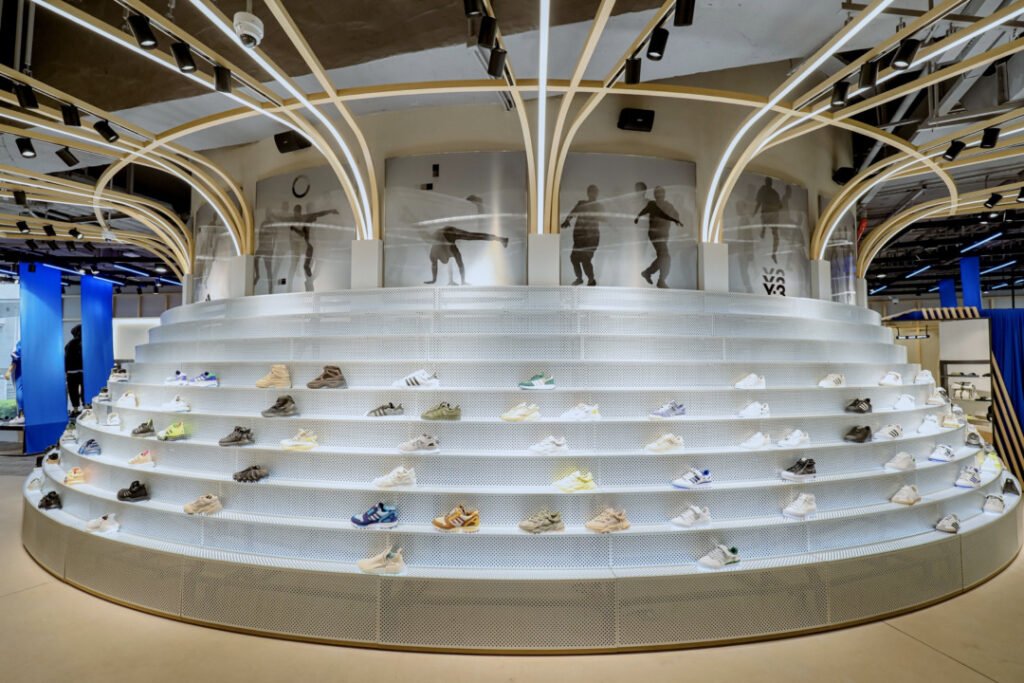Recently, Adidas’ first RFID smart fitting store in the Asia-Pacific region officially debuted in Shanghai. This is the first RFID store built by Adidas in China and the Asia-Pacific region: With the automatic identification technology of RFID electronic tags, customers can personally feel the magic of RFID smart fitting rooms.
After the customer enters the fitting room, the clothing will be automatically identified and displayed in the RFID fitting mirror, and different sizes and colors can be changed through human-computer interaction, and the fitting experience can be improved under professional advice, bringing customers a high level Retail innovation and digital service experience. With the increasingly fierce offline competition in the footwear industry, working hard on interactive applications has become a major innovation that businesses focus on.

01. RFID is becoming more and more popular in the field of shoes and clothing
In fact, RFID technology has been used in the field of footwear and clothing for a long time. The well-known brands such as Decathlon, Nike, Adidas, Zara, and Uniqlo have already introduced RFID technology in their operations to improve their design and production, logistics supply, and retail services.
With the development of technology and the continuous maturity of scene applications, RFID has been applied in major links such as clothing design and production, warehousing and logistics, terminal retail, and washing services, and has become an important technology to promote the digital transformation of the clothing industry. The introduction of RFID and other digital management methods has not only greatly improved the production and operation efficiency of the footwear industry, but also made the brand’s business strategy more flexible.
The application of RFID in the field of footwear and clothing is not uncommon. They have generally been in the application of RFID for more than ten years and have accumulated a lot of application experience. In this process, RFID has gradually played more value from the simple inventory efficiency improvement from the beginning.
In recent years, under the wave of digitization, many brands are promoting related pilot projects and gradually promoting the application of RFID.
02. Forced interactive application scenarios
Further release of RFID potential
Previously, the application of RFID in the field of shoes and clothing tended to be simple data-based operations, which greatly improved the efficiency of data collection in some links, thereby achieving rapid inventory, logistics visualization, and rapid settlement, etc., and smart fitting mirrors have significant effects on them. Different, the main difference is that the value of the latter is reflected in the ability to interact after recognition. Through innovation in interaction, what is finally achieved is the upgrade of consumers’ consumption experience.
The 3D somatosensory dressing mirror is a system integration platform that integrates hardware and software. Customers can not only quickly switch clothing styles, but also get real-time matching solutions provided by professional designers. For merchants, the interactive data generated during the interaction can be analyzed to obtain the analysis of consumer habits and preferences, and then improve the store business model.
In fact, many footwear manufacturers have begun to pay attention to the potential of RFID in terms of interaction. For example, the clothing networking system launched by Haier, a well-known domestic appliance company, has put a lot of effort into laundry washing. Haier’s “Smart Washing” platform is equipped with RFID technology that enables washing machines to truly “recognize” clothes, automatically identify the fabric and color of the clothes, and automatically match the washing program based on the information related to the clothes.
With the continuous deepening of the application of RFID technology in the footwear industry, the degree of integration of RFID technology with other technologies is getting higher and higher, including cloud computing, big data, automation and other technologies, so that greater value can be achieved. The development direction of industry digitization.
03. Open up the data link of the industry chain
RFID will promote more innovation
At present, although UHF RFID tag production capacity is mainly concentrated in China, the end customers are still mainly foreign brands. However, the domestic shoe and apparel industry is shifting from large-scale development to high-quality development. Intelligence and networking have become important directions for technology and industrial upgrading and development, prompting the shoe and apparel industry to transform from labor-intensive to capital-technology-intensive.
At the same time, with the continuous improvement of domestic consumption levels, market demand is more fragmented and more diversified. The traditional supply chain operation of footwear companies has been significantly behind, there is a mismatch of front and back supply and demand information, long product turnover time, and inability to timely Adapting to changes in market demand and other issues, ultimately leading to sales blockage and inventory backlog.






